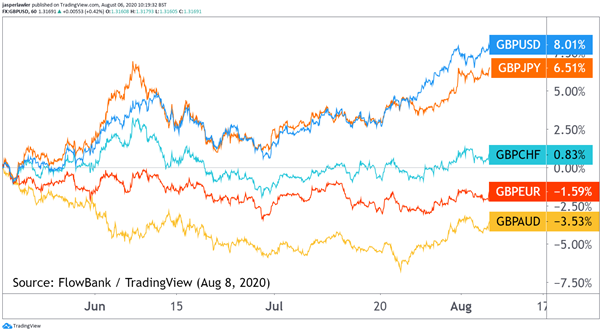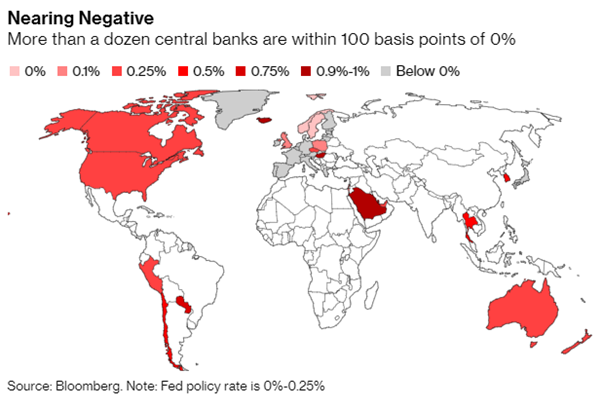The British pound has jumped to a 5-month high (GBP/USD) after the Bank of England concluded it was better to avoid negative interest rates in the UK.
What happened?
The BOE’s Monetary Policy Committee decided to keep interest rates at 0.1% and importantly played down the prospect of negative interest rates. Both Europe and Japan are employing negative interest rates and the UK failing to follow suit is a positive for the UK currency.
The central bankers also released the quarterly inflation report in which it forecast a shallower recession but a more drawn-out recovery for the UK economy. Forecasts for lower unemployment and higher inflation in 2021 added to the bullish sentiment towards GBP.
BoE Economic Projections:
UK CPI 0.25% In 2020 (May Scenario: 0.6%)
UK CPI 1.75% In 2021 (May Scenario: 0.5%)
UK Unemployment 7.5% In 2020 (May Scenario: 8%)
UK Unemployment 6% In 2021 (May Scenario: 7%)
Chart
British pound versus major currencies (3-months)
GBP has performed best against ‘haven’ currencies the USD and JPY in the last 3-months, while underperforming in 3-months (but gaining over 1 month) in other cross rates.
While UK -ve rates happen?
The Bank of England had this to say:
“At present, banks’ balance sheets will be negatively affected by the period of severe economic disruption arising from Covid-19. And they have an important role to play in helping the U.K. economy recover by providing finance for individuals and companies. As a result, negative policy rates at this time could be less effective as a tool to stimulate the economy.”
Bloomberg helpfully provided the map above, which shows many countries teetering on the edge of negative rates with interest rates close to zero. That included the UK as well as Australia, New Zealand, Canada and the United States.
The Bank of England is making the best argument against negative interest rates- and that’s that it will harm banks, insurance companies and pension funds. London is the financial capital of the world, which makes it a bigger consideration for the UK than Europe and in Japan.
BUT… markets are still pricing in negative interest rates in late 2021. That is because the argument for negative interest rates - a COVID-19 inspired severe recession / depression has not yet materialised (largely because of government support). Based on the policy response this time, another downturn or simply a national second wave of the coronavirus will mean higher government spending and a higher national debt.
Negative rates are probably the best way to go about the very bad idea of monetary financing.
Add on top that the UK has still not finished its transition period with the European Union so the full impact of Brexit is still unknown, nor is the shape of any trade deal with the EU.
What happens to GBP?
If you’re of the view that this review from the BOE means the risk of negative interest rates is no more material in the UK than other developed countries (including the US) then that would imply more upside in GBP. If you think this review is just denying the inevitable and negative rates are still coming, you’d likely conclude that any more upside in Sterling will be temporary.
Read our next article: Non-farm payrolls: EUR/USD trading strategy






